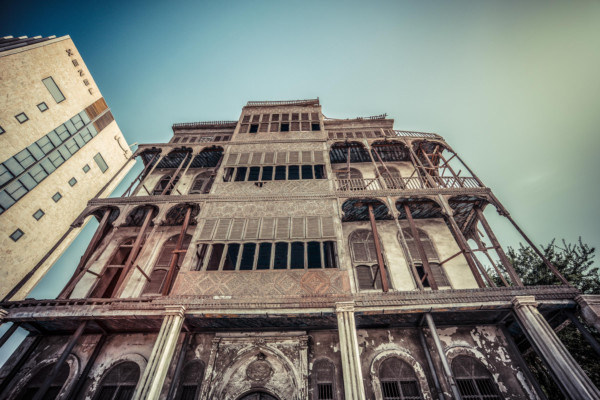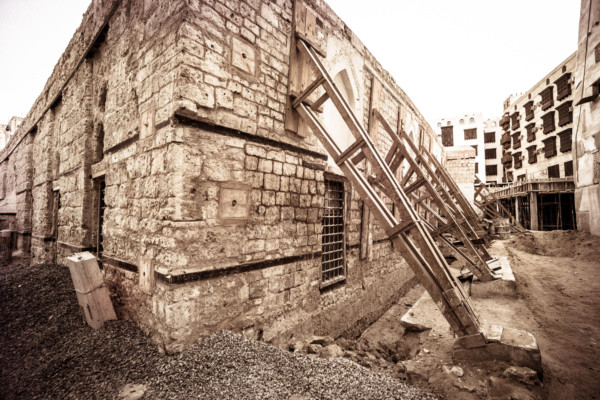
A joint exhibition by Sarah Abudawood and Samir Nicolas Saddi, titled “Jeddah: Al Balad”, is a celebration of the historical old city of Jeddah in Saudi Arabia, which was declared a Unesco World Heritage Site in 2014. Over the past 2,500 years, Jeddah has been a major port on the Red Sea, and the gateway for Muslim pilgrims arriving by sea for the Haj, making it a thriving trade centre and a meeting place of different cultures. This is reflected in the distinctive architecture of Al Balad, located in the heart of the city.
Al Balad, which can be literally translated as “The City”, features historical landmarks such as the Old Jeddah Wall built to protect the old city, ancient mosques, tower houses built in the late 19th century by wealthy merchants, lively traditional souqs and narrow, winding alleys. But with the development of Jeddah, this heritage area is also changing.
Abudawood and Saddi have captured the beauty of this charming old quarter as well as the transformation that is happening there through their stunning photographs of old buildings with arched doorways, and latticed windows and balconies, the vendors on the streets, ancient mosques, the crumbling old city walls and city gate, a cemetery, and even an abandoned “haunted” house.
The images tell us about the way of life in a bygone era, and the harmony that existed between the built and natural environment in old times, but they also remind us of the heritage that is being lost due to the replacement of traditional building methods and materials by new ideas and technologies that are not in tune with local conditions.
Dubai-based Abudawood was born in Jeddah in 1979 and grew up in the city. She studied graphic arts in the US, but it was the architecture of London that inspired her to become a photographer. What makes her pictures interesting is the unusual perspectives from which she has photographed the buildings, giving a contemporary touch to the old, time-worn structures.
“My mission is to create an image that captivates the audience through an un-conformist-compositional approach via the use of dramatic angles, theatrical lighting, plunging-oblique views and pared-down compositions that are vulnerable to abstraction. It is in that platform of exchange that a photograph comes to life. In this series, my objective as an artist was to give a voice and create a platform for these buildings that have been deprived the opportunity to tell their long overdue stories,” she says.
Saddi is a Canadian-Lebanese architect and photographer with a passion for researching and documenting the traditional architecture of this region. He has worked on major construction and restoration projects in Africa, Canada, Europe and the Arab world, including landmark projects such as the Museum of Islamic Art and the National Museum in Qatar, and the Louvre Abu Dhabi.
In 1975, he founded the Arab Research Centre for Architecture and Design of the Environment (ARCADE) to address the urgent need of documenting the fragile built environment in the region and to propose innovative approaches for a sustainable and bio-climatically responsive contemporary architecture through researching past architecture.
Over the last four decades, Saddi has researched and documented the endangered architecture of many old cities such as Sana’a, Isfahan, Cairo, Aleppo, Tripoli and Saida, and he has exhibited his photographs of African and Arab traditional and contemporary architecture around the world. In the mid 1990s, he spent two years shooting the architecture of Al Balad, and has more than 1,500 images of this unique heritage.
Saddi spoke to Weekend Review about the significance of Al Balad, and of documenting and researching the traditional architecture of the region. Excerpts:
How did you get interested in researching and documenting the traditional architecture of Africa and the Arab world?
I have been fascinated with vernacular architecture in different parts of the world since I began studying architecture. I discovered vernacular African architecture when I was working on my PhD in Paris in 1975, and from 1976 to 1980 I travelled extensively in West and North Africa, across the Sahara to research and document what had been wrongly labelled as “primitive architecture”.
Such a trip is not possible anymore due to wars and terror groups. Such research and documentation is important because traditional architecture is very fragile and cannot last without by-laws protecting it. It has also to face wars and uncontrolled developments, especially in our region. We have seen the scale and character of Beirut changing due to the war and uncontrolled real estate operations; and with the ongoing conflicts in the Arab world, and the rapid development in the GCC countries, the need to record and research what is left of the traditional built environment in the region remains urgent.
Why did you choose to focus on Al Balad?
I was living in Canada when I first saw images of Old Jeddah in the 1990s. The pictures motivated me to travel and work in Jeddah to explore this amazing heritage. I spent almost five years between 1993 and 1997 photographing the houses, streets and architectural details such as doors and “rowshans”. It has taken more than a decade for Old Jeddah to be included in the list of World Heritage Sites, and during this period many old buildings have been damaged or have simply disappeared.
Why is the area so important?
Al Balad represents the original one square kilometre from which modern Jeddah developed. Its buildings have been standing for more than 200 years and still hold valuable lessons in terms of passive design and green buildings for the harsh and extreme climate. The vernacular architecture of Hijaz, the western province of Saudi Arabia along the Red Sea, was influenced by the extreme humidity throughout the year, and evolved into a refined building art and technology.
Jeddah played a prominent role as a trading port, and the cross-cultural exchange between the trading Middle-Eastern, Asian and European nations enriched the arts and architecture of Hijaz. The Haj pilgrims who came from various parts of the world also brought their skills and ideas. This area is very important as the last example of a living historic city in Saudi Arabia, hence preserving Old Jeddah and regenerating its structures is a must.
We must raise awareness among politicians and potential developers about the uniqueness of the Jeddah historic core as a city with remaining architectural characteristics, and mostly as an opportunity for sustainable redevelopment. It is important not only to preserve and sustain Al Balad as part of the Unesco World Heritage but also, most importantly, to regenerate its urban fabric and research its wealth of architectural solutions for the climate and context of a historic city in a hot-humid zone.
What are the distinctive features of these buildings?
What is amazing about Old Jeddah buildings is the variety of rowshans or mashrabiyas as well as the façade treatment for each building. The rowshans are transparent wooden screens that allowed cross ventilation and provided privacy for the family. They became decorative later, acquired popularity and influenced architecture in various locations such as Makkah, Madinah up to Taif.
We have the potential of developing an amazing contemporary architecture by researching how this city developed and how these structures were laid and conceived. Every building is different but they are all members of one family and this is amazing. For me Al Balad is a living laboratory of architectural research, where as a professor of urban architecture I can bring my students to explore the wealth of spatial and architectural solutions embedded in this living heritage.
Are the buildings in your photographs still standing, and are they still inhabited?
I went to Jeddah and visited Al Balad last year. I was shocked to see that many historic buildings have disappeared and some that are still standing are in bad shape compared to what they were 20 years ago. Lack of maintenance is one reason and this is due to the fact that for a long time, these buildings have not been occupied by the families who built them but rather by working people of various nationalities.
Why did you want to exhibit these photographs in Dubai?
Dubai is the centre of now and the idea of this exhibition on Old Jeddah happening in Dubai is to trigger interest, especially among Saudis and Emiratis. I was happy that many old residents of Jeddah came to the opening. They recognised the buildings in the photographs and recalled many stories about the glorious past. I hope to take this exhibition to Al Balad in the coming months, along with a great book.
Showing what used to be Old Jeddah 20 years ago is very important for me as the founder of ARCADE and as an architect and urban planner. Most of the buildings you see in this exhibition are dilapidated or gone. But I have a huge archive of images and data collected between 1995 and 1997, which I hope can contribute to the revival of this amazing city someday.
How can this revival happen?
The only way to save these buildings and what is left of Al Balad is to create incentives for smart developers to regenerate its urban structure by renovating key buildings and transforming them into boutique hotels, galleries, shopping areas, etc. This is happening on a small scale now.
Jyoti Kalsi is an arts-enthusiast based in Dubai.
“Jeddah: Al Balad” will run at The Empty Quarter gallery, DIFC, until September 15.














